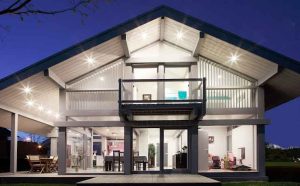Popularization of new materials used in prefabricated houses
With the rapid development of science and technology and the deepening of the concept of sustainable development, the construction industry is undergoing unprecedented changes. Prefabricated houses, as an important part of modern construction, are built with new materials that not only improve building performance, but also greatly contribute to energy saving, emission reduction and environmental protection.
This article will take you to understand several new building materials commonly used in prefabricated houses and their characteristics and applications.Below is more popularization about the material.

Liquid wood
Liquid wood is a very innovative environmentally friendly building materials, which is made of lignin (fiber industry offcuts) and hemp mixed and heated. This material is injected into hollow molds to cure and mold after heating. Because its main components are natural substances, Liquid Wood is far more environmentally friendly than traditional building materials.
It not only realizes the utilization of waste, but also conforms to the concept of sustainable development. In prefabricated houses, liquid wood can be used to make wall panels, floors and other components, which are both lightweight and strong, and have good thermal insulation properties.
Aluminum film panels
Aluminum film panels, also known as aluminum alloy templates, have been rapidly gaining popularity in the construction industry since their birth in the United States in the 1950s with their unique advantages. Aluminum membrane plate is easy to install and dismantle, and the turnover times are up to more than 120 times, which is much higher than the traditional formwork.
The quality of concrete appearance can reach the standard of fair-faced concrete, which greatly improves the aesthetics of the building. In the construction process of prefabricated houses, aluminum film panels not only reduce the consumption of wood, but also improve construction efficiency and reduce construction costs.
In recent years, with the rise of BIM (Building Information Modeling) technology, the application of aluminum film panels has become more efficient, and the template dimensions can be accurately designed through BIM modeling, thus shortening the construction time.
High-performance concrete
High performance concrete is one of the indispensable materials in prefabricated houses. Compared with traditional concrete, it has higher strength and durability and can effectively resist the erosion of the external environment.
In the key parts of prefabricated houses such as beams, columns and walls, the application of high-performance concrete greatly improves the stability and safety of the structure. In addition, high-performance concrete also has good thermal insulation properties, which helps to reduce building energy consumption and improve living comfort.
Lightweight bricks and composite materials
Lightweight bricks are favored in the construction of prefabricated houses for their low density and good thermal insulation properties. It not only reduces the self-weight of the building, but also facilitates construction and transportation.
Composite materials, on the other hand, are made from a combination of two or more materials and offer superior mechanical properties and corrosion resistance. In the exterior wall decoration, roof and interior walls and other parts, the application of composite materials not only enhances the aesthetics of the building, but also enhances its durability.
Intelligent Building Materials
With the development of Internet of Things technology, intelligent building materials are gradually entering the construction of prefabricated houses. These materials are able to sense environmental changes and automatically adjust their performance, such as light, temperature, etc.. In smart buildings, the application of smart building materials greatly improves living comfort and energy efficiency.
For example, smart windows can automatically adjust the light transmission rate according to the external light, and smart walls can adjust the thermal insulation performance according to the indoor temperature changes.
Future Trends
Looking to the future, the new materials used in prefabricated houses will continue to develop in the direction of intelligent, green, multifunctional and personalized. With the continuous progress of science and technology, intelligent building materials will become more and more popular, to achieve automatic monitoring and regulation, and improve the intelligent level of the building.
Meanwhile, the demand for environmentally friendly materials will continue to grow, and the construction industry will pay more attention to the renewability and environmental friendliness of the materials. In addition, new building materials will have more functionalities, such as heat insulation, waterproofing and anti-bacteria, etc., which will comprehensively improve the performance of buildings.
With the diversification of consumer demand, construction materials will also be more personalized and customized to meet the needs of different users.
In summary, new materials used in prefabricated houses are gradually changing the face of the construction industry with their unique advantages. Through continuous technological innovation and application promotion, we have reason to believe that the future prefabricated houses will be more environmentally friendly, efficient and intelligent, creating a better living environment for human beings.
We will have more popularization about prefabricated houses, if you are interested please pay more attention!
Know more:https://new.qq.com/rain/a/20240712A0AJXI00
Post time: 09-03-2024







